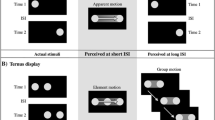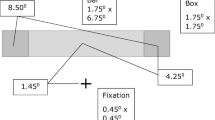Abstract
A photograph of an action contains implicit information about the depicted motion. Previous studies using either psychophysics or neuroimaging suggested that the neural processing of implied-motion images shares some features of real-motion processing. According to the hypothesis that the target depicted in photographs with implied motion is mentally represented as continuing in motion, such kind of photographs should be processed by the brain similarly to the individual frames of a running movie. In order to decode the functional significance of a movie, we must be able to estimate the duration of each frame and the time interval between successive frames as precisely as possible. Therefore, under naturalistic conditions, one would expect that the precision of time duration estimates is higher for action pictures than for still pictures. To test this prediction, we asked human observers to compare the variable duration of test photographs with the reference duration of their scrambled version. We found that, as expected, the duration of photographs with implied motion was discriminated better than the duration of photographs without implied motion. We also found that the average reaction time for the discrimination of photographs with implied motion was longer than that for photographs without implied motion, suggesting that the processing of implied motion involves longer and/or slower neural routes to compute time duration. This longer processing may depend on the engagement of two visual systems in parallel, one for processing form and the other one for processing implied motion. The perceptual decision about time duration would occur after the convergence of signals from these two pathways.



Similar content being viewed by others
References
Agresti A (2002) Categorical Data Analysis, 2nd edn. Wiley, N J
Baayen RH, Davidson DJ, Bates DM (2007) Mixed-effects modeling with crossed random effects for subjects and items. J Mem Lang 59(4):390–412. doi:10.1016/j.jml.2007.12.005
Bates D, Maechler M (2010) lme4: linear mixed-effects models using S4 classes. R package version 0.999375-33. http://CRAN.R-project.org/package=lme4. Accessed 10 Sep 2010
Bosco G, Carrozzo M, Lacquaniti F (2008) Contributions of the human temporoparietal junction and MT/V5+ to the timing of interception revealed by transcranical magnetic stimulation. J Neurosci 28(46):12071–12084. doi:10.1523/JNEUROSCI.2869-08.2008
Brown SW (1995) Time, change, and motion: the effects of stimulus movement on temporal perception. Percept Psychophys 57(1):105–116
Bueti D, Baharami B, Walsh V (2008) Sensory and association cortex in time perception. J Cogn Neurosci 20(6):1054–1062. doi:10.1162/jocn.2008.20060
Casella G, Berger RL (2002) Statistical inference, 2nd edn. Duxbury, Pacific Grove
Cicchini GM, Morrone MC (2009) Shifts in spatial attention affect the perceived duration of events. J Vis 9(1):1–13
Forstmann BU, Anwander A, Schäfer A, Neumann J, Brown S, Wagenmakers EJ, Bogacz R, Turner R (2010) Cortico-striatal connections predict control over speed and accuracy in perceptual decision making. Proc Natl Acad Sci USA 107(36):15916–15920
Freyd JJ (1983) The mental representation of movement when static stimuli are viewed. Percept Psychophys 33(6):575–581
Gil S, Rousset S, Droit-Volet S (2009) How liked and disliked foods affect time perception. Emotion 9(4):457–463
Hoffman L, Rovine MJ (2007) Multilevel models for the experimental psychologist: foundations and illustrative examples. Behav Res Methods 39(1):101–117
Hubbard TL (2005) Representational momentum and related displacement in spatial memory: a review of the findings. Psychon Bull Rev 12(5):822–851
Itti L, Koch C (2000) A saliency-based search mechanism for overt and covert shifts of visual attention. Vision Res 40(10–12):1489–1506
Itti L, Koch C (2001) Feature combination strategies for saliency-based visual attention systems. J Electron Imag 10(1):161–169
Kanai R, Paffen CL, Hogendoorn H, Verstraten FA (2006) Time dilation in dynamic visual display. J Vis 6(12):1421–1430. doi:10.1167/6.12.8
Kaneko S, Murakami I (2009) Perceived duration of visual motion increases with speed. J Vis 9(7):1–4. doi:10.1167/9.7.14
Kourtzi Z, Kanwisher N (2000) Activation in human MT/MST by static images with implied motion. J Cogn Neurosci 12(1):48–55. doi:10.1162/08989290051137594
Krekelberg B, Dannenberg S, Hoffmann KP, Bremmer F, Ross J (2003) Neural correlates of implied motion. Nature 424(6949):674–677. doi:10.1038/nature01852
Lorteije JA, Kenemans JL, Jellema T, van der Lubbe RH, de Heer F, van Wezel RJ (2006) Delayed response to animate implied motion in human motion processing areas. J Cogn Neurosci 18(2):158–168. doi:10.1162/jocn.2006.18.2.158
Lorteije JA, Barraclough NE, Jellema T, Raemaekers M, Duijnhouwer J, Xiao D, Oram MW, Lankheet MJ, Perrett DI, van Wezel RJ (2010) Implied motion activation in cortical area middle temporal can be explained by visual low-level features. J Cogn Neurosci [Epub ahead of print]
Luce RD (1986) Response times. Oxford University Press, N Y
Milner AD, Goodale MA (2008) Two visual systems re-viewed. Neuropsychologia 46(3):774–785. doi:10.1016/j.neuropsychologia.2007.10.005
Morrone MC, Ross J, Burr D (2005) Saccadic eye movements cause compression of time as well as space. Nat Neurosci 8(7):950–954. doi:10.1038/nn1488
New JJ, Scholl BJ (2009) Subjective time dilation: spatially local, object-based, or a global visual experience? J Vis 9(2):4. doi:10.1167/9.2.4
Palmer J, Huk AC, Shadlen MN (2005) The effect of stimulus strength on the speed and accuracy of a perceptual decision. J Vis 5(5):376–404
R Development Core Team (2010) R: a language and environment for statistical computing. R foundation for statistical computing, Vienna. ISBN: 3-900051-07-0, http://www.R-project.org. Accessed 10 Sep 2010
Senior C, Barnes J, Giampietro V, Simmons A, Bullmore ET, Brammer M, David AS (2000) The functional neuroanatomy of implicit-motion perception or representational momentum. Curr Biol 10(1):16–22
Treutwein B (1995) Adaptive psychophysical procedures. Vision Res 35(17):2503–2522
Tse PU, Intriligator J, Rivest J, Cavanagh P (2004) Attention and the subjective expansion of time. Percept Psychophys 66(7):1171–1189
Walther D, Koch C (2006) Modelling attention to salient proto-objects. Neural Netw 19(9):1395–1407
Wichmann FA, Hill NJ (2001) The psychometric function: I. Fitting, sampling, and goodness of fit. Percept Psychophys 63(8):1293–1313
Winawer J, Huk AC, Boroditsky L (2008) A motion aftereffect from still photographs depicting motion. Psychol Sci 19(3):276–283. doi:10.1111/j.1467-9280.2008.02080.x
Acknowledgments
We thank the AIKI—Italian School of Aikido and the IOC—International Olympic Committee for allowing the use of some photographs used in this study. Research was supported by grants from the Italian Space Agency, the Italian Ministry of University and Research, and the Italian Ministry of Health.
Author information
Authors and Affiliations
Corresponding author
Rights and permissions
About this article
Cite this article
Moscatelli, A., Polito, L. & Lacquaniti, F. Time perception of action photographs is more precise than that of still photographs. Exp Brain Res 210, 25–32 (2011). https://doi.org/10.1007/s00221-011-2598-y
Received:
Accepted:
Published:
Issue Date:
DOI: https://doi.org/10.1007/s00221-011-2598-y




